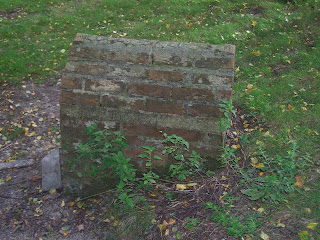There is no evidence of an earlier structure on the site, and I will earmark this for further research. The well is adjacent to an old toll house that marked the beginning of a turnpike. This was demolished in 1876. There is nothing at the site to suggest that there was an earlier well here and it is possible that the shaft was bored especially for the jubilee, to portray the monarch as benevolent provider of drinking water, perhaps, or to demonstrate the largesse of the Parish and its leading members, along with the village's love of the Queen-Empress. See: http://www.benendenvillage.org.uk/notes.htm for a little more detail.
As can be seen, the pump mechanism has been removed from this well, probably for recycling into military hardware in World War Two, like many of its kind. This also needs verification.
There is a similar well, built in 1897 to commemorate the Diamond Jubilee, in the village of Iden Green, to the SW of Benenden. The 1:50k OS map shows that there was a Roman ford (NGR to follow), and surely therefore a road, between the two present-day settlements. Neither of these wells are marked on the 1:50k map.
The Benenden Well is near an ornamental lake called New Pond and a moated manor house, the former of which belonged to the latter. Both of these are at the southern extremity of the Hemsted Estate, now the site of Benenden School, where a great house has been situated since at least 1377. I will look into the relationship between these buildings.
just3days, the NWI Videographer reports a similar 1887 well in Staffordshire, in a posting to the NWI forum (http://nwi.skyphos.co.uk/phpbb/viewtopic.php?t=172) made on September 5th 2007. Tim says:
' Tip off from a librarian at Barton Under Needwood yielded a well called the Queen's Well at Dunstall, for Victoria's Jubilee in 1887. Nothing on any databases - but anything about this well being here earlier, or any holy attributes? SK 1820 2078 ' (Tim Prevett, NWI Index, Sept. 2007).
I will visit Iden Green as soon as I am able, and will research both wells. For now, here are some shots of the Queen's Well at Benenden:
















